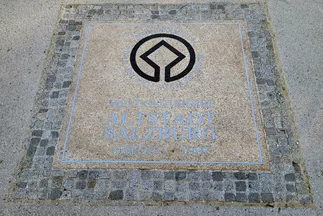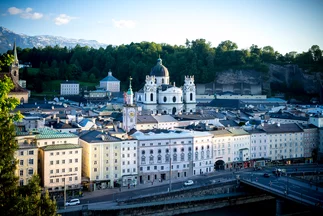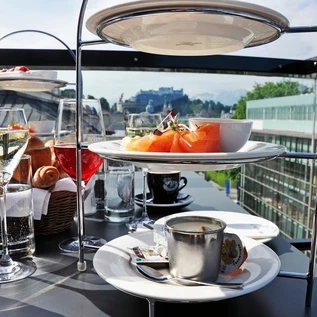Visit us at
Couple at Mozartplatz in Salzburg | © Tourismus Salzburg GmbH
City feeling
Exploring the UNESCO World Heritage City
There is no better way to experience the magic of a city, and discover its countless little secrets, than on your own two feet. Ideally, during a romantic getaway for two, especially in one of the most coveted travel destinations in all of Europe: the “City of Mozart”, Salzburg.
On a Treasure Hunt through Salzburg
Due to its perfect combination of culture and nature, the city became a UNESCO World Heritage Site more than 25 years ago. Now, the UNESCO City Hike gives us a marvelous opportunity to explore the historic downtown district. So, precisely what gems will enchant us as we stroll through the lanes and squares of Salzburg? Read on, join us on our walk!
Salzburg combines history and the present, art, culture and nature like hardly any other city. This impressive mix is one reason why Salzburg's old town has been a UNESCO World Heritage Site since 1997.
Station 1: The Cathedral – of unicorns and baptized children
We’ll begin in the heart of the Old City, at the Cathedral, in whose baptismal font no less a figure than a certain Wolfgang Amadeus Mozart was baptized. We can also marvel at truly impressive ceiling paintings and stuccowork, along with the art installation “Vanitas” and a richly ornamented organ loft. Tip: Prince Archbishop von Thun immortalized himself by having unicorns – which are featured on his heraldic crest – engraved on the sides of numerous pews.
Station 2: Mozart Square – a selfie with Salzburg’s most famous son
Sauntering past the Baroque fountain of the Residenz with its water-spewing horses, we quickly come to Mozart Square. Our eyes immediately gravitate to the big bronze statue of the great master, with lots of details that bring it to life, including musical notes on a scroll and the buttonholes and shoelaces of Mozart’s clothing. High time, in other words, to snap a selfie with Salzburg’s most famous son. And be sure to take a closer look: Hidden under Mozart’s left hand is a copy of the Roman mosaic that was unearthed as they dug up the ground to put in the foundation for the statue.
Station 3: Nonnberg Abbey and The Sound of Music
Our next stop greets us directly below the fortress: Benedictine Nonnberg Abbey, including an abbey church with excellently preserved frescoes. The oldest convent in Central Europe, it has also gained international fame from the musical “The Sound of Music”, which is based on the autobiography of former novice Maria von Trapp. Secret tip: On the way from the abbey up to the fortress, on a former boundary marker now known as the “Nonnberg Dog”, if you look carefully, you will find two hidden faces.
Station 4: Hohensalzburg Fortress – high above the city rooftops
Now it is time for us to visit the very heart of this UNESCO World Heritage City: Hohensalzburg Fortress. Every Sunday at 11:45 AM, the sounds of distant trumpets echo down from the towers of the fortress above. We ride the fortress funicular up to the dominating emblem of Salzburg. Awaiting us at the biggest fully preserved castle in Central Europe are one-of-a-kind views stretching out across the city and surrounding countryside.
Inside the fortress itself, five separate museums introduce visitors to the architectural as well as military history of Salzburg. A palate-pleasing tip: a photogenic dessert plate known as Salzburger Nockerl, served at the Panorama Restaurant.
Station 5: St. Peter’s Archabbey – sacred, secular & delectable perspectives
We now continue our city hike to St. Peter’s Abbey, home, not only to the abbey church, the cemetery and a library, but also its very own bakery, known as the Stiftsbäckerei. Inside the cemetery, stairs lead up to the Catacombs, hewn out of the Mönchsberg itself. Yet another sensory indulgence: The irresistible smells that waft from the Stiftsbäckerei, carrying 900 years of baking experience. The “Stone Bread” to the right of the entrance to the abbey church attests to the close ties between the abbey and the baker’s craft.
On our way to the next station of our walk, we allow ourselves to make a brief detour to nearby Café Tomaselli, the oldest continuously operated coffeehouse in Austria, where you really sense the essence of what is aptly known as “Salzburg coffeehouse culture”.
Station 6: Festival Halls – a city of music for all
Our next visit takes us to the city’s world-famous festival halls: the Grosses Festspielhaus along with the Haus für Mozart and the Felsenreitschule. They can be visited daily and are a constant source of fascination, including the Faistauer Foyer and a 17 meters-tall Mozart head depicted in Swarovski crystals. Keep your eyes open: Looking down over the main entrance are the theatrical masks that are the symbol of the Salzburg Festival.
Station 7: Mozart’s Birthplace – The Cradle of Music
A short walk now brings us to the Getreidegasse, the “main artery of the Salzburg historic district”. At House No. 9, the Mozart family lived for 26 years and it is also here where little “Wolferl” first saw the light of day in 1756. The museum shows the original rooms as well as pieces including the violin the young musical genius played as a boy. Into details? The doorknocker, in the shape of a lion’s head with snake-like ring in its mouth, reminds us that this was also the home of a pharmacist back in the 16th century.
Station 8: St. Sebastian’s Cemetery – final resting place of prominent personalities
Treading in Mozart’s footsteps, we now cross the River Salzach and make our way to St. Sebastian’s Cemetery, modeled after a classic Italian Camposanto. Lying here are Mozart’s wife Constanze and his father Leopold. Standing in the middle is the burial chapel of Prince-Archbishop Wolf Dietrich, whose goal it was to transform Salzburg into a magnificent “Rome of the North”. Insider Tip: “The dosage makes the poison” – Paracelsus, the originator of this quote, is likewise buried here.
Station 9: Schloss Mirabell & Mirabell Gardens – of women & dwarfs
We now stroll through beautiful Mirabell Gardens and gaze at Schloss Mirabell – the very embodiment of what makes Salzburg a World Heritage Site. Formerly a family estate of the prince-archbishop, today the location, not only of the Salzburg city government, but also “the most romantic wedding hall in Europe”. Interesting detail: Hidden in the walls along the pathway to the historical Dwarf Garden are two women’s faces – all that remains of sandstone figures.
Station 10: Mönchsberg & Inner Mülln – views worth seeing
We now continue to a part of the city by the name of Mülln, which made an interesting contribution to the urban development of Salzburg as a whole. As we cross the Müllner Steg bridge, we are treated to breathtaking views of the historic heart of the city including the fortress. Tip: The ideal location to take your souvenir photos.
The Augustiner Bräu has been an absolute sensation in its own right since 1621. There, partaking in a hearty snack, we end our city hike and look forward to our next city theme hike a little off the beaten track.
City Walk: UNESCO World Heritage Salzburg
Would you like to discover lesser-known places in the city? How about one of our theme hikes – including UNESCO World Heritage City, Beer Culture, Mozart or Creative Salzburg? Detailed maps are available on- and offline – the perfect way to navigate the city during your next Salzburg Trip.
























